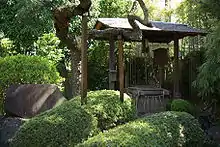| Kamei-in 亀井院 | |
|---|---|
 Kamei-in | |
| Religion | |
| Affiliation | Buddhism |
| Rite | Nichiren-shū |
| Location | |
| Location | 4-4-9 Mama, Ichikawa, Chiba Prefecture |
| Country | Japan |
| Geographic coordinates | 35°44′19.56″N 139°54′34.45″E / 35.7387667°N 139.9095694°E |
| Architecture | |
| Completed | 1635 |
Kamei-in (亀井院) is a Buddhist temple located in the city of Ichikawa in Chiba Prefecture. Kamei-in is a Nichiren Buddhist temple noted for the Mama Well.
History
Kamei-in was built early in the Edo period in 1635 as a retirement temple for the 11th abbot of nearby Guhō-ji. Kamei-in is located directly to the southeast of the Guhō-ji, and remains a sub-temple of it. It was originally called Bin'i-bō. In 1705 an administrator from the Tokugawa shogunate, Nagayori Suzuki, began a restoration of Kame-in using stones from Nikkō Tōshō-gū, in Nikkō, Tochigi Prefecture. The stones were used to build the steps of Kamei-in. Suzuki was censured by the shogunate and committed seppuku over the incident. During this period the temple came to be known as Suzuki-in, but after Nagayori's death the name fell out of use. After the appearance of a mysterious turtle at Kamei-in, the temple came to be known by its current name, a combination of the kanji for turtle (亀) and well (井). Noted early 20th century tanka poet Hakushū Kitahara (1885 – 1942) lived in the monk's quarters of Kamei-in in 1916.[1]
Mama Well

The Mama Well of Kamei-in is referenced in a poem in the Man'yōshū.[2] Takahashi Mushimaro, a low-ranking court official of the Nara period, wrote in the early 8th century poem On the maiden of Mama of Katsushika:
When I see the well at Mama of Katsushika,
It reminds me of Tekona
Who stood here oft, drawing water.[3]
Related places
- Guhō-ji
- Kamei-in faces the Monument and Shrine of Tekona, a temple featured in Hiroshige's One Hundred Famous Views of Edo
Transportation
Kamei-in is located in the Mama District of Ichikawa. It is accessible by foot from the Kōnodai Station on Keisei Electric Railway's Keisei Main Line.
References
- ↑ Chiba-ken Kōtō Gakkō Kyōiku Kenkyūkai Rekishi Bukai (1989), Chiba-ken no rekishi sanpo (1st ed., rev. ed.), Yamakawa Shuppansha, p. 56, ISBN 978-4-634-29120-1
- ↑ 亀井院 (in Japanese)
- ↑ 1969. 1000 poems from the Manyōshū : the complete Nippon Gakujutsu Shinkokai translation. New York, N.Y: Columbia University Press, p. 223-224.